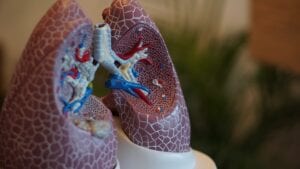Sarcoidosis
What is sarcoidosis?
In healthy people, the immune system knows to defend the body from harmful substances. When these substances are detected, certain cells release chemicals that tell other cells to isolate and destroy the unhealthy invader, causing inflammation. Sarcoidosis occurs when the inflammation doesn’t recede and excess immune system cells form lumps called granulomas. Sarcoidosis can affect any of the body’s organs; however, it often originates in the lungs, skin, and/or lymph nodes. Patients with this disease run the risk of developing pulmonary sarcoidosis, which can lead to pulmonary fibrosis—a chronic disease characterized by altered lung function and labored breathing.
However, very rarely is sarcoidosis fatal; most recover with few or no long-term effects. In fact, more than 50-percent of people with symptoms enter into remission within three years of diagnosis.
What are symptoms of sarcoidosis?
Oftentimes, people with this disease won’t even know they’re experiencing symptoms until the disease is discovered by a routine chest x-ray. Depending on ethnic background, gender, and age, sarcoidosis symptoms will vary. Some of the most common symptoms include coughing, wheezing, shortness of breath, and chest pain. These symptoms, consequently, may cause uneasiness, depression, and fatigue.
What treatment options are available for sarcoidosis?
Not everyone with the disease needs treatment because many times, depending on the patient, symptoms will go away on their own. However, if the brain, heart, or eyes have been affected, a patient will require treatment, such as prednisone, antimalarial medicines, or immunosuppressants. Sarcoidosis treatment aims to relieve symptoms, improve organ function, control inflammation, and prevent pulmonary sarcoidosis, which can lead to lung scarring.
Where can I find more information on sarcoidosis?
Sarcoidosis Articles


Sarcoidosis: Case Study of Presentation as Isolated Orbital Granuloma



Study of the Week: Pulmonary Microbiota is Significantly Less Diverse in People with Sarcoidosis
People with Sarcoidosis Have Less Diverse Pulmonary Microbiota Than Healthy Individuals

Efzofitimod Granted Orphan Drug Designation for Sarcoidosis in the European Union







